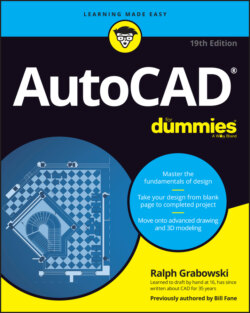Читать книгу AutoCAD For Dummies - Ralph Grabowski - Страница 58
A Zoom with a View
ОглавлениеIN THIS CHAPTER
Zooming and panning
Naming and restoring views
Zooming and panning in paper space layouts
Regenerating the display
One advantage that AutoCAD has over manual drafting is its capability to show you different views of drawings.
You move the viewpoint in, or zoom in, to see a closer view of objects in the drawing; you move the viewpoint out, or zoom out, to see a more expansive (not expensive) view. If you watch TV or movies or own a camera, you should understand zooming.
Panning refers not to looking for gold but to looking at a different part of a drawing without changing the magnification of the view. If you zoom in so that part of the drawing is no longer shown onscreen, you’ll pan around in the drawing to see other parts, without zooming in and out. Think of the monitor as a window through which you look at part of the drawing. Now reach through the window and slide the drawing around until you see a different portion of it through the window.
Panning and zooming do not change the size or position of objects in the drawing. The actions change only how you see them.
In fact, you not only can zoom and pan in the drawing but also, in most kinds of drawings, you must zoom and pan frequently to be able to draw and edit effectively.
Why do you need to pan and zoom often? For starters, though many architectural drawings plot out at 3 feet by 2 feet, you probably aren’t fortunate enough to own a monitor of that size with sufficient resolution to be able to see every little detail.
Early releases of AutoCAD came with a sample drawing of the solar system done to scale. When first opened, it showed circles for each planet’s orbit. Zooming in revealed the moon’s orbit around Earth, then a crater on the moon, then the lunar landing module, and finally writing on the plaque mounted on a leg of the lunar lander.
In addition, technical drawings are jam-packed with lines, text, and dimensions. As discussed in Chapter 8, drawing with precision is essential to following best practices for AutoCAD drawings. Frequent zooming and panning enables you to better see detail, to draw more precisely because you can see what you’re doing, and to edit more quickly, because object selection is easier when the screen isn’t cluttered with objects. This chapter describes the most useful display control features in AutoCAD.
